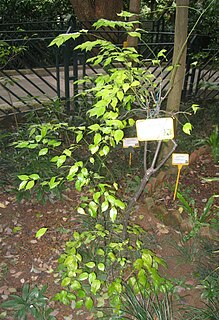This page provides a glossary of plant morphology. Botanists and other biologists who study plant morphology use a number of different terms to classify and identify plant organs and parts that can be observed using no more than a handheld magnifying lens. This page provides help in understanding the numerous other pages describing plants by their various taxa. The accompanying page—Plant morphology—provides an overview of the science of the external form of plants. There is also an alphabetical list: Glossary of botanical terms. In contrast, this page deals with botanical terms in a systematic manner, with some illustrations, and organized by plant anatomy and function in plant physiology.

Zanthoxylum nitidum, commonly known as shiny-leaf prickly-ash, tez-mui or liang mian zhen, is a species of flowering plant in the family Rutaceae. It is a woody climber with prickles on the branchlets, thick, cone-shaped spines on the trunk and older branches, pinnate leaves with five to nine leaflets, and panicles or racemes of white to pale yellow, male or female flowers in leaf axils and on the ends of branchlets.

Zanthoxylum pinnatum, commonly known as yellow wood, is a species of flowering plant of the family Rutaceae native to Lord Howe and Norfolk Islands. It is a tree with pinnate leaves, white male and female flowers arranged in groups in leaf axils, and spherical, purple follicles containing a single black seed.

Zanthoxylum rhetsa, commonly known as Indian prickly ash, is a species of flowering plant in the family Rutaceae and occurs from India east to the Philippines and south to northern Australia. It is a deciduous shrub or tree with cone-shaped spines on the stems, pinnate leaves with between nine and twenty-three leaflets, panicles of white or yellowish, male and female flowers, followed by spherical red, brown or black follicles.

Ilex asprella, also known as rough-leaved holly and plum-leaved holly, is a deciduous shrub native in South East Asia. Ilex asprella is one of the few deciduous species in the family Aquifoliaceae.
Zanthoxylum macranthum , is a species of woody plants in the family Rutaceae. It is native to the upland open forests and thickets in south-east Tibet and southern China, and has been found in Chongqing (Nanchuan), Guizhou, south-west Henan, western Hubei, Hunan, Sichuan, southern Yunnan (Xishuangbanna), and south-east Xizang.
Zanthoxylum austrosinense, or South Chinese Sichuan pepper, is a woody plant in the family Rutaceae and is native to southern China.
Zanthoxylum calcicola is a woody plant in the Rutaceae family. It is native to Yunnan, Guizhou, and Guangxi in China.
Zanthoxylum dissitum is a woody plant native to China. It grows in upland thickets and open forests, forests, at 300-2600 m altitude.
Zanthoxylum echinocarpum is a woody plant in the family Rutaceae and is native to South-Central and Southeast China.
Zanthoxylum esquirolii is a woody plant in the family Rutaceae from Guizhou, Sichuan, and Yunnan China.
Zanthoxylum glomeratum is a woody plant in the Rutaceae family, it is native to Southeast and South-Central China.
Zanthoxylum khasianum is woody plant in the Rutaceae family native to Attam and South Central China.
Zanthoxylum laetum is a species of woody plant from the Rutaceae family.
Zanthoxylum leiboicum is a woody plant in the Rutaceae family and is native to Sichuan in China, and is known there as léi bō huā jiāo (雷波花椒).
Zanthoxylum liboense (Chinese: 荔波花椒 is a plant in the Rutaceae family.
Zanthoxylum micranthum is a woody plant in the family Rutaceae. It is native to Hubei, Hunan, Guizhou, Sichuan, and Yunnan provinces in China.
Zanthoxylum molle is a woody plant from the Rutaceae family.
Zanthoxylum motuoense is a woody plant from the Rutaceae family and is native to Medog, Tibet.
Zanthoxylum undulatifolium is a woody plant from the Rutaceae family. It is native to western Hubei, eastern Sichuan, Taibai Mountain in southern Shaanxi to the Three Gorges of the Yangtze River in China.




